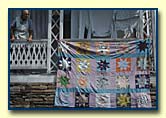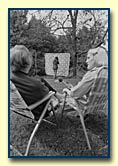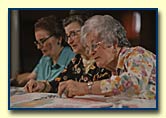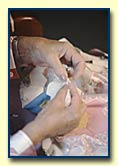
Carrie Severt, laundry, and quilt hanging on porch
Blue Ridge Parkway Folklife Project Collection, 1978
| Blue Ridge Quiltmaking in the Late Twentieth Century |
| by Laurel Horton, July, 1999 |

Carrie Severt, laundry, and quilt hanging on porch Blue Ridge Parkway Folklife Project Collection, 1978 |
On August 24, 1978, Geraldine Johnson was driving down a two-lane road in the North Carolina mountains when she spied quilts hanging on the porch of an old house. She immediately turned around, pulled into the driveway, and knocked at the back door.
Gerri Johnson wasn't a tourist or an antique dealer looking for quilts to buy. She was one of a team of folklorists involved in a research project to identify and document practitioners of traditional customs in the communities of North Carolina and Virginia along a section of the Blue Ridge Parkway. The project was conducted by the Library of Congress's American Folklife Center in cooperation with the National Park Service.
Of the twenty-one folklorists, photographers, Park Service employees, and interns involved in the fieldwork for this project, Gerri Johnson was one of only three women. She had conducted earlier research on rag-rug weavers in western Maryland and was particularly interested in documenting women's crafts for the Blue Ridge folklife survey. Arriving in the area, Johnson and her colleagues began their work by contacting local people in order to identify potential subjects to be interviewed. Johnson was on the way to an appointment when the sight of quilts hanging on a porch changed her plans.
Perhaps if Carrie Severt had not been airing her quilts on that particular day, Johnson would have driven past with only a glance at the handsome old farmhouse. Quilts are generally kept in the private parts of a house, in bedrooms and closets. They are rarely available for public display, and passersby have no way of knowing which houses on a rural road might be treasure troves of quilts. Most of the quiltmakers Johnson met were those whose names had been provided to her by relatives, friends, and craft shop managers. It wasn't her usual practice just to walk up to a house unannounced, but she considered this opportunity too good to pass up.

Lura Stanley with Gerri Johnson, Terry Eiler photographing Lura's quilts in the background Blue Ridge Parkway Folklife Project Collection, 1978 |
Of all the women that Gerri Johnson interviewed during the two months of the project, Carrie Severt most closely matched the folklorist's vision of a traditional quiltmaker. She made her quilts from leftover fabrics, combining them in old, familiar patterns to make serviceable yet attractive quilts which she then gave away to her children and grandchildren.
In the 1970s, many folklorists were seeking "authenticity." Concerned that changes in technology and lifestyle threatened the existence of many aspects of traditional culture, they concentrated their documentation efforts on those people who seemed least influenced by modern events. Since that time, more and more folklorists have broadened their field of study, looking at the ways traditions have changed and adapted rather than seeking only the "purest" examples of continuity. In 1978, however, this team of folklorists was looking for "authentic" mountain culture, and the resulting documents -- photographs, audio recordings, fieldnotes, and published articles -- provide a window through which to view the not-too-distant past.
Much of the project's significance results from historical and demographic circumstances. The majority of the subjects interviewed were elderly and had grown up in the area before World War II. This group formed a living link between the agrarian, farm based, pre-war local economy and the post-war period of accelerated development and change. The Blue Ridge Folklife Survey documented the lives of residents who still practiced traditions learned from their parents but who generally had little expectation that their children and grandchildren would continue them.
Although Johnson was looking for a particular kind of authentic "mountain quilter," what she actually found and documented was a much more complex range of quiltmaking activities that reflected both local, rural traditions and the influence of a national quilt revival. Rather than identifying a homogenous quiltmaking culture, she discovered that each woman's experience was unique. Taken together, the interviews and photographs demonstrate a wide variety of motivations, styles, and processes influencing the ways quilts were made and used in 1978 in this section of the Blue Ridge Mountains.
During the two months of the project, Gerri Johnson collected the names of many more quiltmakers than she had time or opportunity to contact. In the interviews she conducted, about two dozen informants mentioned quilts, and about half of these individuals were, or had been, active quiltmakers. Six of these women are featured in this collection through audio selections and photographs, while additional photographs show the work of other quiltmakers.
Quiltmaking was an integral part of American rural life during the early twentieth century. After quiltmaking declined in popularity during the 1950s and 1960s, there was a national revival of interest in it during the 1970s that led many women to take it up as a hobby. These new quilters often lacked any family connection with quilts. Instead of modeling their creations upon existing family quilts, they turned to books and magazines for examples.
Gerri Johnson was aware of the national quilt revival, and she worried that it would undermine the older, family-based traditions in the area she was studying. As evidence of an authentic quiltmaking tradition, Johnson looked for women who had learned to make quilts at home from relatives or friends rather than by taking classes, and who selected old, familiar, local patterns instead of getting new ones from books and magazines. She looked for women who made quilts to use as bedcovers rather than for decoration or as wall hangings. She was interested in women who gave quilts as gifts to family members rather than selling them to strangers. And she wanted to meet women who were mountain natives who considered quiltmaking a part of their everyday lives, not just a passing fancy.

Eunice McAlexander, Lora King and Crystal Cruise quilting at frame Blue Ridge Parkway Folklife Project Collection, 1978 |
The "quilting bee" that brought women together to work on a quilt is such a cherished activity in the popular mind that some writers consider it a metaphor for democracy. Quilting in groups has a long and varied history in the United States, but the need for the romantic image largely overshadows its reality. During the twentieth century, most group quilting has taken place in churches to raise money for capital expenditures or for foreign or domestic missions. Gerri Johnson documented two group-quilting activities, but she noted that one of these groups rarely met. Instead, its members set the quilt up in a central location and dropped in to quilt when they could. By 1978, the active lives of many Americans, even those past retirement age, made it difficult to coordinate group activity.
For many Americans, the Appalachian region has become stereotypically associated with poverty. Indeed, the "boom and bust" economic cycles associated with extractive industries, principally coal mining and logging, along with the difficulties of operating small farms, have contributed to a chronically depressed economy in the region. However, as Gerri Johnson found, the region reflects a wide range of economic circumstance, from great poverty to great wealth. Because the rugged terrain and natural beauty of the region have attracted large numbers of tourists since the end of the nineteenth century, early economic development efforts often involved encouraging or teaching local residents to make crafts to sell to tourists. These early efforts were so successful that, even today, there is a widespread belief that craft items made in the mountains are better or more "authentic" than identical items made in other parts of the country.
While the influence of the tourist industry on the production of mountain crafts dates back to the early twentieth century, the federal government's "War on Poverty" programs spurred the formation of additional craft cooperatives during the late 1960s and 1970s. Gerri Johnson visited a number of craft shops scattered along the Blue Ridge Parkway. Some of these, she felt, did an excellent job of marketing the work of local crafters, while others sold work that was neither local nor traditional. While some of the craft shop managers were helpful in providing the names of quilters, others feared that the quilt documentation project would cost them sales.

Crystal Cruise piecing a Flower Garden quilt Blue Ridge Parkway Folklife Project Collection, 1978 |
Since 1978, the market for handmade quilts has undergone a radical transformation. As American quiltmakers began to charge higher prices for their work, enterprising companies responded to the popular demand for inexpensive quilts by importing copies of American traditional quilts from developing countries such as Haiti and China. Competition from imported quilts has had a serious impact on the sales of American hand crafted quilts.
Much has changed since Johnson interviewed mountain quiltmakers in 1978. Most of these women have died, and their quilts have been distributed among family and friends. The national quiltmaking revival has had a widespread impact, as younger women have taken up the craft with enthusiasm. Quilters of all ages have formed clubs and guilds, attend classes to learn new techniques, and buy new fabric to make quilts that are primarily decorative. Local and regional exhibitions display both historic and contemporary quilts.
As the collective memory of older quiltmakers fades, new quilters create memories
of their own. What links the generations, however, is a profound respect for the traditions
of the past. Younger quilters typically express a fascination with earlier quilts and their
makers. They often say that while making a quilt, they feel connected spiritually to a long
line of creative and resourceful women. Although the lives of these younger women are
very different from the lives of those who grew up in the Blue Ridge Mountains in the early
twentieth century, they share a recognition of the creative spirit and an appreciation of a
shared tradition.